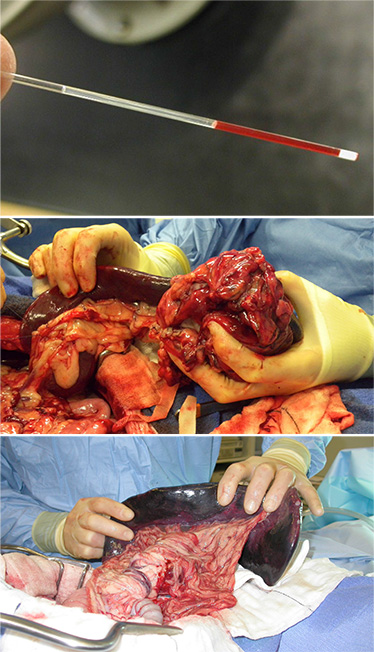
Soft Tissue Surgery
The most common cause in dogs is acute non-traumatic haemoabdomen secondary to malignant neoplasia causing splenic rupture. Other causes include trauma, iatrogenic following surgery (e.g. ovariectomy) or diagnostics (e.g. FNA), coagulopathies or torsion of the liver or spleen.
Abdominocentesis will reveal blood that does not clot. The PCV of the blood will be similar to the periphery. Stabilisation includes IVFT and a blood transfusion if necessary. Identification of the underlying cause includes abdominal ultrasound and thoracic radiographs if indicated.
Most cases of traumatic haemoabdomen can be managed conservatively. The exceptions are if there is evidence of a penetrating injury or bite wounds. Also, if the animals’ PCV continues to drop despite appropriate IVFT and blood transfusions, exploratory laparotomy is indicated. If the haemoabdomen is spontaneous and a bleeding tumour is suspected, exploratory laparotomy and removal is indicated once the animal has been stabilised. Coagulopathies must be ruled out prior to surgery.
Monitor the peripheral PCV and consider a transfusion if the dog is clinically affected by the anaemia. In some cases, a transfusion will be lifesaving, in others it will not be lifesaving but will be helpful in improving the oxygen carrying capacity.
Tips for splenectomy
- Large laparotomy and excision of falciform fat
- Use abdominal retractors
- The omentum is often stuck to a bleeding splenic mass so bunch ligate it using 3 metric Vicryl (Ligapacks are handy to speed things up)
- The closer the spleen you ligate, the less likely you are to damage the blood supply to the left limb of the pancreas. However this is time consuming as there are many smaller vessels. Visualise the tip of the left limb of the pancreas and ensure all ligatures are distal to it.
- Double ligate the splenic artery and artery separately to avoid arteriovenous fistulas. There are advantages as to which vessel to ligate first.
- Ligating the artery first reduces the blood supply to a bleeding tumour
- Ligating the vein first stops tumour seeding to the systemic circulation
- For splenic torsion cases, do not derotate the spleen prior to removal to prevent inflammatory cytokines and thrombi entering the systemic circulation
- Palpate the pulsing artery and ligate this first. Ideally, ligate it separely to the vein, if this is not possible then ligate toehter
- Bunch ligate in small sections the rest of the omentum/vessels, again paying close attention the location of the pancreas
- Examine the pancreas after splenectomy in case of trauma to the distal tip

Case Advice or Arranging a Referral
If you are a veterinary professional and would like to discuss a case with one of our team, or require pre-referral advice about a patient, please call 01883 741449. Alternatively, to refer a case, please use the online referral form